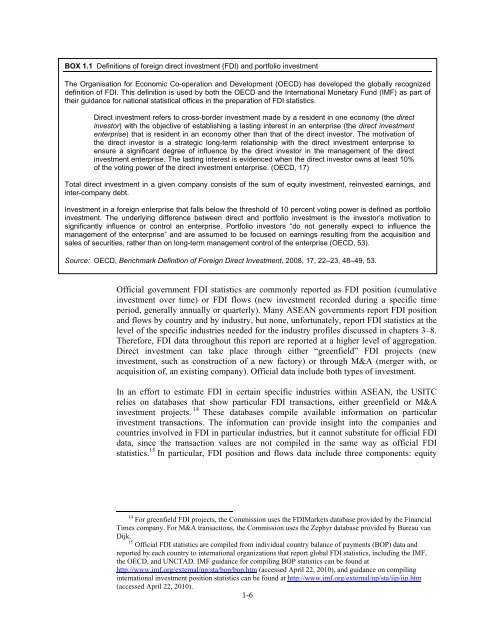ASEAN: Regional Trends in Economic Integration, Export ... - USITC
ASEAN: Regional Trends in Economic Integration, Export ... - USITC
ASEAN: Regional Trends in Economic Integration, Export ... - USITC
Create successful ePaper yourself
Turn your PDF publications into a flip-book with our unique Google optimized e-Paper software.
BOX 1.1 Def<strong>in</strong>itions of foreign direct <strong>in</strong>vestment (FDI) and portfolio <strong>in</strong>vestment<br />
The Organisation for <strong>Economic</strong> Co-operation and Development (OECD) has developed the globally recognized<br />
def<strong>in</strong>ition of FDI. This def<strong>in</strong>ition is used by both the OECD and the International Monetary Fund (IMF) as part of<br />
their guidance for national statistical offices <strong>in</strong> the preparation of FDI statistics.<br />
Direct <strong>in</strong>vestment refers to cross-border <strong>in</strong>vestment made by a resident <strong>in</strong> one economy (the direct<br />
<strong>in</strong>vestor) with the objective of establish<strong>in</strong>g a last<strong>in</strong>g <strong>in</strong>terest <strong>in</strong> an enterprise (the direct <strong>in</strong>vestment<br />
enterprise) that is resident <strong>in</strong> an economy other than that of the direct <strong>in</strong>vestor. The motivation of<br />
the direct <strong>in</strong>vestor is a strategic long-term relationship with the direct <strong>in</strong>vestment enterprise to<br />
ensure a significant degree of <strong>in</strong>fluence by the direct <strong>in</strong>vestor <strong>in</strong> the management of the direct<br />
<strong>in</strong>vestment enterprise. The last<strong>in</strong>g <strong>in</strong>terest is evidenced when the direct <strong>in</strong>vestor owns at least 10%<br />
of the vot<strong>in</strong>g power of the direct <strong>in</strong>vestment enterprise. (OECD, 17)<br />
Total direct <strong>in</strong>vestment <strong>in</strong> a given company consists of the sum of equity <strong>in</strong>vestment, re<strong>in</strong>vested earn<strong>in</strong>gs, and<br />
<strong>in</strong>ter-company debt.<br />
Investment <strong>in</strong> a foreign enterprise that falls below the threshold of 10 percent vot<strong>in</strong>g power is def<strong>in</strong>ed as portfolio<br />
<strong>in</strong>vestment. The underly<strong>in</strong>g difference between direct and portfolio <strong>in</strong>vestment is the <strong>in</strong>vestor’s motivation to<br />
significantly <strong>in</strong>fluence or control an enterprise. Portfolio <strong>in</strong>vestors “do not generally expect to <strong>in</strong>fluence the<br />
management of the enterprise” and are assumed to be focused on earn<strong>in</strong>gs result<strong>in</strong>g from the acquisition and<br />
sales of securities, rather than on long-term management control of the enterprise (OECD, 53).<br />
Source: OECD, Benchmark Def<strong>in</strong>ition of Foreign Direct Investment, 2008, 17, 22–23, 48–49, 53.<br />
Official government FDI statistics are commonly reported as FDI position (cumulative<br />
<strong>in</strong>vestment over time) or FDI flows (new <strong>in</strong>vestment recorded dur<strong>in</strong>g a specific time<br />
period, generally annually or quarterly). Many <strong>ASEAN</strong> governments report FDI position<br />
and flows by country and by <strong>in</strong>dustry, but none, unfortunately, report FDI statistics at the<br />
level of the specific <strong>in</strong>dustries needed for the <strong>in</strong>dustry profiles discussed <strong>in</strong> chapters 3–8.<br />
Therefore, FDI data throughout this report are reported at a higher level of aggregation.<br />
Direct <strong>in</strong>vestment can take place through either “greenfield” FDI projects (new<br />
<strong>in</strong>vestment, such as construction of a new factory) or through M&A (merger with, or<br />
acquisition of, an exist<strong>in</strong>g company). Official data <strong>in</strong>clude both types of <strong>in</strong>vestment.<br />
In an effort to estimate FDI <strong>in</strong> certa<strong>in</strong> specific <strong>in</strong>dustries with<strong>in</strong> <strong>ASEAN</strong>, the <strong>USITC</strong><br />
relies on databases that show particular FDI transactions, either greenfield or M&A<br />
<strong>in</strong>vestment projects. 14 These databases compile available <strong>in</strong>formation on particular<br />
<strong>in</strong>vestment transactions. The <strong>in</strong>formation can provide <strong>in</strong>sight <strong>in</strong>to the companies and<br />
countries <strong>in</strong>volved <strong>in</strong> FDI <strong>in</strong> particular <strong>in</strong>dustries, but it cannot substitute for official FDI<br />
data, s<strong>in</strong>ce the transaction values are not compiled <strong>in</strong> the same way as official FDI<br />
statistics. 15 In particular, FDI position and flows data <strong>in</strong>clude three components: equity<br />
14 For greenfield FDI projects, the Commission uses the FDIMarkets database provided by the F<strong>in</strong>ancial<br />
Times company. For M&A transactions, the Commission uses the Zephyr database provided by Bureau van<br />
Dijk.<br />
15 Official FDI statistics are compiled from <strong>in</strong>dividual country balance of payments (BOP) data and<br />
reported by each country to <strong>in</strong>ternational organizations that report global FDI statistics, <strong>in</strong>clud<strong>in</strong>g the IMF,<br />
the OECD, and UNCTAD. IMF guidance for compil<strong>in</strong>g BOP statistics can be found at<br />
http://www.imf.org/external/np/sta/bop/bop.htm (accessed April 22, 2010), and guidance on compil<strong>in</strong>g<br />
<strong>in</strong>ternational <strong>in</strong>vestment position statistics can be found at http://www.imf.org/external/np/sta/iip/iip.htm<br />
(accessed April 22, 2010).<br />
1-6

















